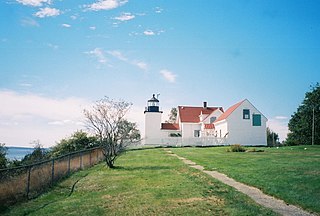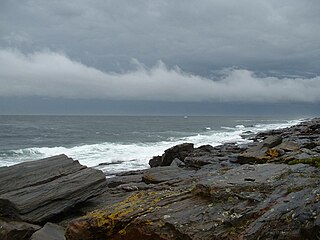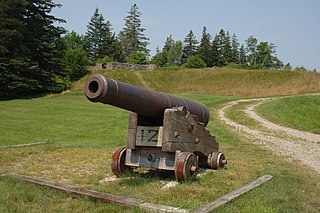
Stockton Springs is a town in Waldo County, Maine, United States. The population was 1,533 at the 2020 census. Stockton Springs is home to Fort Point State Park and Fort Point Light, both located on Fort Point, a peninsula on Cape Jellison.
The Waldo Patent, a letters patent also known as the Muscongus Patent or the Lincolnshire Patent, was a document granting title to 36 square miles (9,300 ha) of land in what is now the U.S. state of Maine. It is named variously for businessman Samuel Waldo, who eventually gained control of the patent, and for the Muscongus River, one of the grant's boundaries.

The Penobscot River is a 109-mile-long (175 km) river in the U.S. state of Maine. Including the river's West Branch and South Branch increases the Penobscot's length to 264 miles (425 km), making it the second-longest river system in Maine and the longest entirely in the state. Its drainage basin contains 8,610 square miles (22,300 km2).

Fort Knox, now Fort Knox State Park or Fort Knox State Historic Site, is located on the western bank of the Penobscot River in the town of Prospect, Maine, about 5 miles (8.0 km) from the mouth of the river. Built between 1844 and 1869, it was the first fort in Maine built entirely of granite; most previous forts used wood, earth, and stone. It is named after Major General Henry Knox, the first U.S. Secretary of War and Commander of Artillery during the American Revolutionary War, who at the end of his life lived not far away in Thomaston. As a virtually intact example of a mid-19th century granite coastal fortification, it was added to the National Register of Historic Places in 1969 and declared a National Historic Landmark on December 30, 1970. Fort Knox also serves as the entry site for the observation tower of the Penobscot Narrows Bridge that opened to the public in 2007.

Dummer's War (1722–1725) is also known as Father Rale's War, Lovewell's War, Greylock's War, the Three Years War, the Wabanaki-New England War, or the Fourth Anglo-Abenaki War. It was a series of battles between the New England Colonies and the Wabanaki Confederacy, who were allied with New France. The eastern theater of the war was located primarily along the border between New England and Acadia in Maine, as well as in Nova Scotia; the western theater was located in northern Massachusetts and Vermont at the border between Canada and New England. During this time, Maine and Vermont were part of Massachusetts.

Fort Edgecomb, built in 1808–1809, is a two-story octagonal wooden blockhouse with restored fortifications located on Davis Island in the town of Edgecomb, Lincoln County, Maine, United States. It is the centerpiece of the Fort Edgecomb State Historic Site. It was added to the National Register of Historic Places in 1969, with its boundaries increased to create a historic district in 1991.

Fort Halifax is a former British colonial outpost on the banks of the Sebasticook River, just above its mouth at the Kennebec River, in Winslow, Maine. Originally built as a wooden palisaded fort in 1754, during the French and Indian War, only a single blockhouse survives. The oldest blockhouse in the United States, it is preserved as Fort Halifax State Historic Site, and is open to the public in the warmer months. The fort guarded Wabanaki canoe routes that reached to the St. Lawrence and Penobscot Valleys via the Chaudière-Kennebec and Sebasticook-Souadabscook rivers. The blockhouse was declared a National Historic Landmark and added to the National Register of Historic Places in 1968.

Fort O'Brien State Historic Site, also known as Fort Machias, preserves the remains of a fort located in Machiasport, Maine that was built and destroyed three times over a 90-year period. It was involved in military actions during the American Revolutionary War and the War of 1812, and was listed on the National Register of Historic Places. It is now managed by the Maine Department of Conservation's Bureau of Parks and Lands, and is open between Memorial Day and Labor Day.

Cape Jellison is a 1,600-acre (6.5 km2) peninsula that juts into Penobscot Bay on the coast of Maine. In colonial times it was known as Wasaumkeag Point. It is part of the town of Stockton Springs, between Searsport and Bucksport, in the upper mid-coast region of the state. It was the site of the first port facility built by the Bangor and Aroostook Railroad.

The Fort Point Light, or Fort Point Light Station, is located in Fort Point State Park, in Stockton Springs, Maine. A lighthouse at this point has served as an active aid to navigation since 1835; the present lighthouse dates to 1857, and is listed on the National Register of Historic Places.

Fort Kent, located at the confluence of the Fish and Saint John rivers in the town of Fort Kent, Maine, is the only surviving American fortification built during the border tensions with neighboring New Brunswick known as the Aroostook War. It is preserved as the Fort Kent State Historic Site, which features an original log blockhouse that is open for visits in the summer. The fort was added to the National Register of Historic Places in 1969 and declared a National Historic Landmark in 1973.

Two Lights State Park is a public recreation area occupying 41 acres (17 ha) of headland on Cape Elizabeth, Maine, that offers views of Casco Bay and the Atlantic Ocean. The state park, which opened in 1961, is named after the twin Cape Elizabeth Lights, although there are no lighthouses in the park itself. In addition to rocky headlands, the park includes the remains of a World War II–era seacoast battery bunker and a fire control tower. It is managed by the Maine Department of Agriculture, Conservation and Forestry.

Colonial Pemaquid State Historic Site is a publicly owned historic property operated by the state of Maine near Pemaquid Beach in Bristol, Maine. The site includes the reconstructed Fort William Henry, archaeological remains of 17th- and 18th-century village buildings and fortifications, and a museum with artifacts found on the site including musket balls, coins, pottery, and early hardware.

The Owls Head Light is an active aid to navigation located at the entrance of Rockland Harbor on western Penobscot Bay in the town of Owls Head, Knox County, Maine. The lighthouse is owned by the U.S. Coast Guard and licensed to the American Lighthouse Foundation. It is the centerpiece of 13-acre (5.3 ha) Owls Head State Park and was added to the National Register of Historic Places as Owls Head Light Station in 1978.

Fort George was a palisaded earthwork fort built in 1779 by Great Britain during the American Revolutionary War in Castine, Maine. Located at a high point on the Bagaduce Peninsula, the fort was built as part of an initiative by the British to establish a new colony called New Ireland. It was the principal site of the British defense during the Massachusetts-organized Penobscot Expedition, a disastrous attempt in July and August of 1779 to retake Castine in response to the British move. The British re-occupied Castine in the War of 1812 from September 1814 to April 1815, rebuilding Fort George and establishing smaller forts around it, again creating the New Ireland colony. The remains of the fort, now little more than its earthworks, are part of a state-owned and town-maintained park.

Fort Sullivan was a 19th-century military fortification in Eastport, Maine. It lay opposite New Brunswick, Canada, and served as an important coastal defense for the easternmost United States of America during the 19th century. As part of the establishment of New Ireland during the War of 1812, British Commodore Sir Thomas Hardy, 1st Baronet conquered the fort in 1814 and renamed it Fort Sherbrooke after John Coape Sherbrooke, the Governor of Nova Scotia.
Warren Island State Park is state-owned island and public recreation area on Penobscot Bay in the town of Islesboro, Waldo County, Maine. The 70-acre (28 ha) state park sits about ½-mile from Islesboro Island and 3 miles (4.8 km) offshore from the mainland at Lincolnville. The island was acquired by the state of Maine for one dollar in 1959. Hiking trails, campsites, and open-faced shelters are found on the island; a pier allows access by private boat.
Birch Point State Park is a public recreation area occupying 62 acres (25 ha) on Penobscot Bay in the town of Owls Head, Knox County, Maine. The state park features a sandy, crescent-shaped "pocket beach" with scenic views of the Muscle Ridge Islands dotting Muscle Ridge Channel. The park is managed by the Maine Department of Agriculture, Conservation and Forestry.

Moose Point State Park is a day-use public recreation area overlooking Penobscot Bay in Searsport, Maine, located off U.S. Route 1 near the Belfast town line. The state park features panoramic views, hiking trails, tidal pools, and picnicking facilities.

Fort Point State Park is a public recreation area that overlooks Penobscot Bay from the easternmost tip of Cape Jellison in the town of Stockton Springs, Maine. The state park's 156 acres (63 ha) feature the Fort Point Light and the site of historic Fort Pownall. The park offers hiking trails, picnicking, and fishing.

















